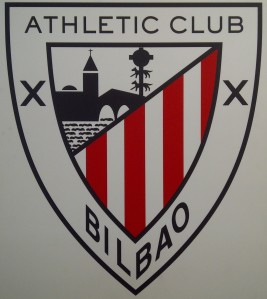 Last night the local European football team Bilboko Athletic Kluba, better known as “Athletic Bilbao,” tied Barcelona 2-2. Apparently everyone else in the world knew that this was happening, and cared a great deal about it. Not us — we were attending a Galician shellfish festival at the plaza de toros here in Bilbao. The five of us (our California pal Anne Chadwick is visiting) sat at a one end of a long table under a big tent with hundreds of other gastronomes of all ages wolfing down unpronounceable but delicious dishes of crab, octopus, scallops, mussels, clams, and various species of shrimp with huge hunks of fresh bread and a very nice white wine, an albariño from Galicia’s Don Pedro de Soutomaior, no relation to the US Supreme Court justice.
Last night the local European football team Bilboko Athletic Kluba, better known as “Athletic Bilbao,” tied Barcelona 2-2. Apparently everyone else in the world knew that this was happening, and cared a great deal about it. Not us — we were attending a Galician shellfish festival at the plaza de toros here in Bilbao. The five of us (our California pal Anne Chadwick is visiting) sat at a one end of a long table under a big tent with hundreds of other gastronomes of all ages wolfing down unpronounceable but delicious dishes of crab, octopus, scallops, mussels, clams, and various species of shrimp with huge hunks of fresh bread and a very nice white wine, an albariño from Galicia’s Don Pedro de Soutomaior, no relation to the US Supreme Court justice.
Walking home and seeing much of the city in a frenzy, I was more conscious than usual of my total disconnect from, and complete indifference to, the wide world of televised competitive sport. My two brothers think I am crazy — worse, criminally insane — for not having attended a single game, even when Real Madrid was in town. Barcelona is the most famous soccer team in the world, and the local team … well, let’s just say that Bilbainos are fiercely proud of them and devoted to their cause because, to play on Athletic Bilbao, you must be Basque, with a first name like Aitor or Gorka, so they don’t do as well as they might if they were allowed to buy ringers from Argentina named after 1980s pop stars like Barcelona’s Lionel Messi, whose six-story face on a banner with Kobe Bryant promoting Turkish Airlines we are staring at every time we emerge from the Bilbao airport.
No, superstar Messi scored the tying goal last night, but his 44th La Liga goal of the season (hey, I really sound like I know my sports talk, don’t I? how a-bout them Niners?) couldn’t save his team from accusations of “lackluster performance” on their supposedly unassailable march toward the title. Athletic Bilbao had lost their last six games against Barcelona, so the town went bazonkers over this tie game, sort of like the headline from the Sixties, “Harvard Beats Yale 29-29,” which is, by the way, also the title of a wonderful film that even I, who detests American football, very much enjoyed.
Director Kevin Rafferty‘s documentary digs into the political crosscurrents of that 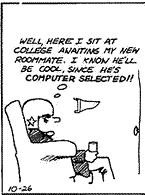 legendary down-to-the-wire 1968 game, when Yale represented blue bloods who supported the Vietnam War, and the underdog Harvard players, including Tommy Lee Jones, scholarship kids who demonstrated against it. The Doonesbury comic strip was born from this rivalry, as were Meryl Streep‘s career and Al Gore‘s Internet. Likewise, here in Spain during the Franco dictatorship, El Caudillo‘s favorite team Real Madrid represented the Fascists, and Barcelona disguised the then-prohibited Catalan language as unintelligibly shouted cheers, so every match was more than just a game; it was like a proxy revolution.
legendary down-to-the-wire 1968 game, when Yale represented blue bloods who supported the Vietnam War, and the underdog Harvard players, including Tommy Lee Jones, scholarship kids who demonstrated against it. The Doonesbury comic strip was born from this rivalry, as were Meryl Streep‘s career and Al Gore‘s Internet. Likewise, here in Spain during the Franco dictatorship, El Caudillo‘s favorite team Real Madrid represented the Fascists, and Barcelona disguised the then-prohibited Catalan language as unintelligibly shouted cheers, so every match was more than just a game; it was like a proxy revolution.
Today we are pleased to learn from our own American right wing that soccer, along with bicycle and pedestrian paths, white wine, and high-speed trains, are part of a socialist plot to undermine capitalist values. (See “Is World Cup soccer socialist?”) According to certain state legislators in New Hampshire and Georgia, the US government, aided by a Cold War brainwashing program code-named Delphi, is putting the UN’s “Agenda 21” into operation, whereby, as The Economist sums it up, tongue firmly in cheek, “Every time you walk or bike somewhere instead of driving your car, U Thant wins.” Or, presumably, every time you watch a soccer game and have a glass of chardonnay instead of football and a beer, chalk one up for the New World Order.
Last week my Bilbaino friend Mikel treated Amy and me to a walking tour of San Mamés stadium, a.k.a. La Catédral for the quasi-religious devotion inspired by el fútbol among Europeans in general, and specifically here where the team is the perennial underdog. Most bars, shops, and apartment terraces display Athletic symbols, and it’s not unusual to walk past a café in which a majority of males under 50 are wearing the red-and-white striped team shirt. Furthermore, every public place is hung with at least one flat screen showing whatever game is currently in play.
The San Mamés lobby features big blow-ups of famous players from days gone by, and a stuffed lion hunted by one of the team’s past owners.( ‘The Lions” became the team’s nickname because San Mamés was built near a cathedral of the same name commemorating the eponymous saint who was thrown to them.) The dressing rooms have historic photos on each locker, and the roof over the home team side of the stadium is supported by a giant suspension arch, so no view-blocking pillars are needed.

Legendary Athletic Bilbao goalie and manager José Ángel Iribar Cortajarena, nicknamed El Chopo (“the poplar”) deflects one in the 1950s.
In fact, next to the stadium a new one is going up, and they haven’t yet figured out how to duplicate the roof trick. But it’s sure to be bigger and better, allowing the old stadium to be replaced by blocks of flats so residents will be able to cross the street to the cathedral, with probably a stop at the corner sports bar called, of course, Bar La Catédral, which according to Mikel pours the coldest capitalist beer in town.
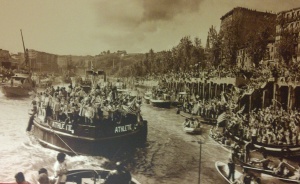
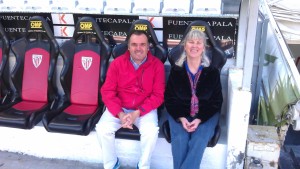
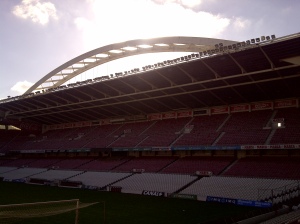
Leave a comment